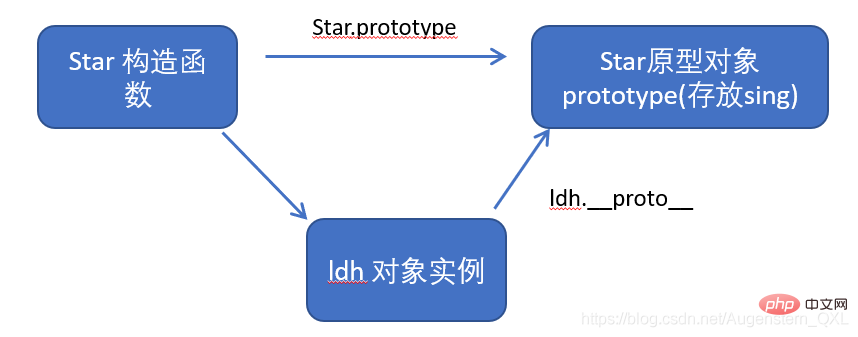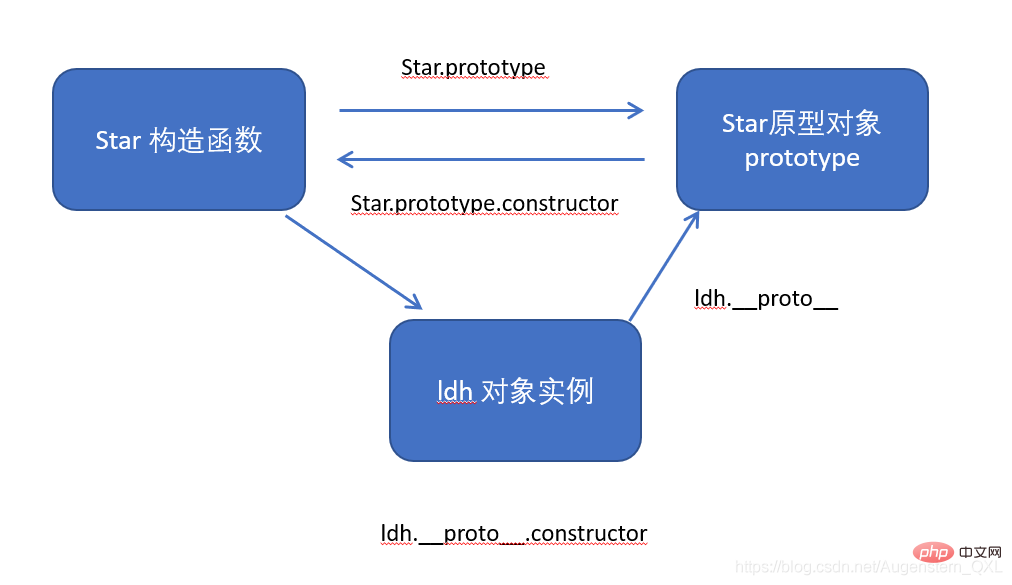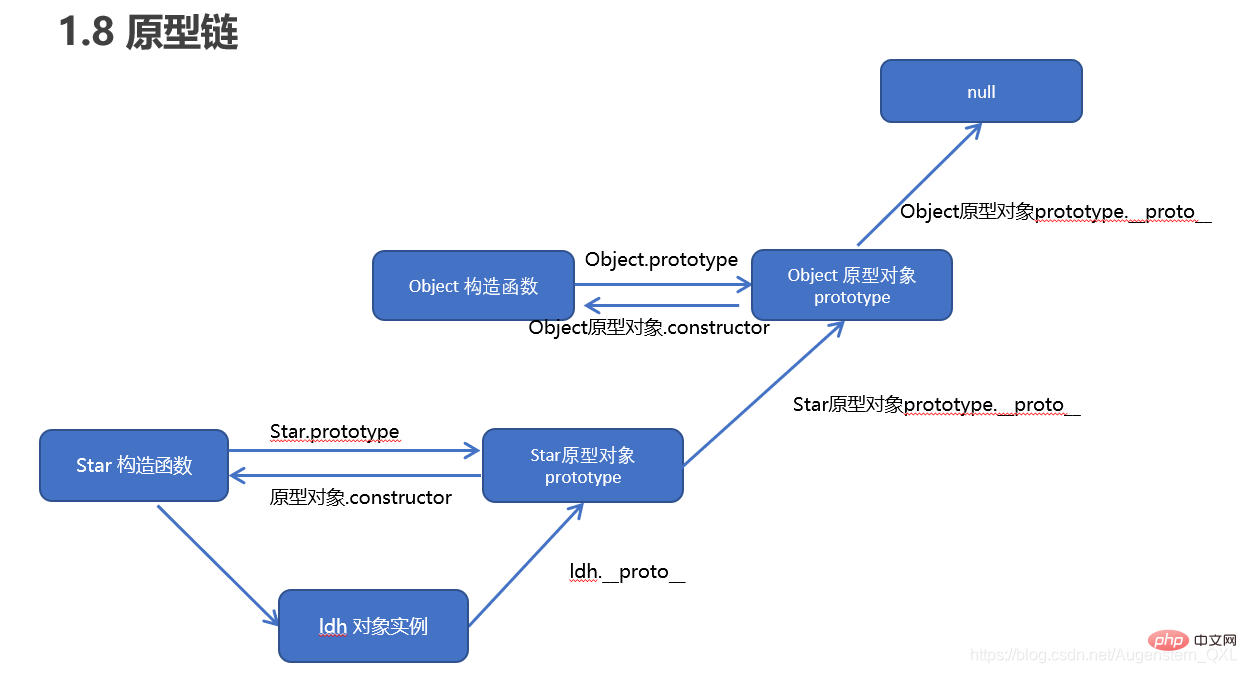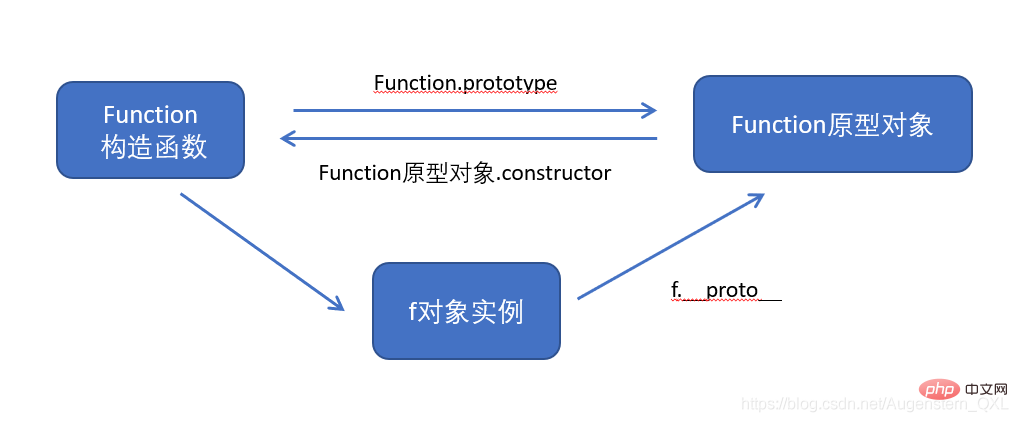爆肝整理JavaScript之物件導向(總結分享)
本篇文章為大家帶來了關於JavaScript中物件導向的相關知識,其中包括物件導向、建構函式以及繼承的相關問題,希望對大家有幫助。

1、物件導向
物件導向更貼近我們的實際生活, 可以使用物件導向描述現實世界事物. 但是事物分為具體的事物和抽象的事物
物件導向的思考特徵:
- 抽取(抽象)物件共用的屬性和行為組織(封裝)成一個類別(模板)
- 對類別進行實例化, 取得類別的物件
#1.1、物件
在JavaScript 中,物件是一組無序的相關屬性和方法的集合,所有的事物都是對象,例如字串、數值、陣列、函數等。
物件是由屬性和方法組成的
- #屬性:事物的特徵,在物件中用屬性來表示
- 方法:事物的行為,在物件中用方法來表示
1.2、類別
在ES6 中新增加了類別的概念,可以使用class 關鍵字宣告一個類,之後以這個類別來實例化物件。
- 類別抽象化了物件的公共部分,它泛指某一大類(class)
- 物件特指某一個,透過類別實例化一個具體的物件
1.2.1、建立類別
class name {
// class body}- 建立實例 ##
var XX = new name();
注意:類別必須使用new 實例化物件
1.2.2、建構子
constructor()方法是類別的建構子(預設方法),用於傳遞參數,傳回實例物件,透過new 指令產生物件實例時,自動呼叫該方法。如果沒有顯示定義, 類別內部會自動為我們建立一個constructor()
<script>
// 1. 创建类 class 创建一个 明星类
class Star {
// constructor 构造器或者构造函数
constructor(uname, age) {
this.uname = uname;
this.age = age;
}
}
// 2. 利用类创建对象 new
var ldh = new Star('刘德华', 18);
var zxy = new Star('张学友', 20);
console.log(ldh);
console.log(zxy);</script>- 透過class 關鍵字建立類,類別名稱我們還是習慣性
- 定義首字母大寫 類別裡面有個
- constructor
函數,可以接收傳遞過來的參數,同時傳回實例物件 - constructor
函數只要new 產生實例時,就會自動呼叫這個函數,如果我們不寫這個函數,類別也會自動產生這個函數#最後注意語法規範 - 建立類別➡類別名稱後面不要加小括號
- 產生實例➡類別名稱後面加小括號
- 建構子不需要加function 關鍵字
1.2.3、類別中新增方法
語法:class Person {
constructor(name,age) {
// constructor 称为构造器或者构造函数
this.name = name;
this.age = age;
}
say() {
console.log(this.name + '你好');
}} var ldh = new Person('刘德华', 18); ldh.say()注意: 方法之間不能加逗號分隔,同時方法不需要新增function 關鍵字。
<script>
// 1. 创建类 class 创建一个 明星类
class Star {
// 类的共有属性放到 constructor 里面
constructor(uname, age) {
this.uname = uname;
this.age = age;
}
sing(song) {
console.log(this.uname + song);
}
}
// 2. 利用类创建对象 new
var ldh = new Star('刘德华', 18);
var zxy = new Star('张学友', 20);
console.log(ldh);
console.log(zxy);
// (1) 我们类里面所有的函数不需要写function
// (2) 多个函数方法之间不需要添加逗号分隔
ldh.sing('冰雨');
zxy.sing('李香兰');</script>- 類別的共有屬性放到
- constructor
裡面類別裡面的函數都不需要寫 - function
關鍵字
1.3 、類別的繼承
現實中的繼承:子承父業,例如我們都繼承了父親的姓。 程式中的繼承:子類別可以繼承父類別的一些屬性和方法。 語法:// 父类class Father {
}// 子类继承父类class Son extends Father {
}<script>
// 父类有加法方法
class Father {
constructor(x, y) {
this.x = x;
this.y = y;
}
sum() {
console.log(this.x + this.y);
}
}
// 子类继承父类加法方法 同时 扩展减法方法
class Son extends Father {
constructor(x, y) {
// 利用super 调用父类的构造函数
// super 必须在子类this之前调用
super(x, y);
this.x = x;
this.y = y;
}
subtract() {
console.log(this.x - this.y);
}
}
var son = new Son(5, 3);
son.subtract();
son.sum();</script>1.4、super關鍵字
- ##super
- 關鍵字用於存取和呼叫物件父類別上的函數,
可以呼叫父類別的建構函數,也可以呼叫父類別的普通函數
語法:
// 父类class Person {
constructor(surname){
this.surname = surname;
}}// 子类继承父类class Student entends Person {
constructor(surname,firstname) {
super(surname); //调用父类的 constructor(surname)
this.firstname = firstname; //定义子类独有的属性
}}注意:
子類別在建構子中使用super,必須放到this前面(必須先呼叫父類別的建構方法,在使用子類別建構方法)案例:
// 父类class Father {
constructor(surname){
this.surname = surname;
}
saySurname() {
console.log('我的姓是' + this.surname);
}}// 子类继承父类class Son entends Father {
constructor(surname,firstname) {
super(surname); //调用父类的 constructor(surname)
this.firstname = firstname; //定义子类独有的属性
}
sayFirstname() {
console.log('我的名字是:' + this.firstname);
}}var damao = new Son('刘','德华');damao.saySurname();damao.sayFirstname();語法:
class Father {
say() {
return '我是爸爸';
}}class Son extends Father {
say(){
// super.say() super调用父类的方法
return super.say() + '的儿子';
}}var damao = new Son();console.log(damao.say());- 多個方法之間不需要新增逗號分隔
- 繼承中屬性與方法的尋找原則:
- 就近原則,先看子類,再看父類
在ES6中類別沒有變數提升,所以必須先定義類,才能透過類別實例化物件
- 類別裡面的 共有屬性與方法
- 一定要加this使用
類別裡面的this - 指向:
constructor 裡面的- this
- 指向實例物件
方法裡面的this - 指向這個方法的呼叫者
<button>点击</button> <script> var that; var _that; class Star { constructor(uname, age) { // constructor 里面的this 指向的是 创建的实例对象 that = this; this.uname = uname; this.age = age; // this.sing(); this.btn = document.querySelector('button'); this.btn.onclick = this.sing; } sing() { // 这个sing方法里面的this 指向的是 btn 这个按钮,因为这个按钮调用了这个函数 console.log(that.uname); // that里面存储的是constructor里面的this } dance() { // 这个dance里面的this 指向的是实例对象 ldh 因为ldh 调用了这个函数 _that = this; console.log(this); } } var ldh = new Star('刘德华'); console.log(that === ldh); ldh.dance(); console.log(_that === ldh); // 1. 在 ES6 中类没有变量提升,所以必须先定义类,才能通过类实例化对象 // 2. 类里面的共有的属性和方法一定要加this使用. </script>登入後複製 - 指向實例物件
2.1、概述
在典型的OOP 的語言中(如Java),都存在類別的概念,類別就是物件的模板,而物件就是類別的實例,但在ES6之前, JS 中並沒用引入類別的概念。
ES6, 全名為 ECMAScript 6.0 ,2015.06 發行版。但目前瀏覽器的 JavaScript 是 ES5 版本,大多數高版本的瀏覽器也支援 ES6,不過只實現了 ES6 的部分特性和功能。
在 ES6之前 ,对象不是基于类创建的,而是用一种称为构建函数的特殊函数来定义对象和它们的特征。
- 创建对象有三种方式
- 对象字面量
- new Object()
- 自定义构造函数
// 1. 利用 new Object() 创建对象var obj1 = new Object();// 2. 利用对象字面量创建对象var obj2 = {};// 3.利用构造函数创建对象function Star(uname,age) {
this.uname = uname;
this.age = age;
this.sing = function() {
console.log('我会唱歌');
}}var ldh = new Star('刘德华',18);注意:
- 构造函数用于创建某一类对象,其首字母要大写
- 构造函数要和
new一起使用才有意义
2.2、构造函数
-
构造函数是一种特殊的函数,主要用来初始化对象(为对象成员变量赋初始值),它总与
new一起使用 - 我们可以把对象中的一些公共的属性和方法抽取出来,然后封装到这个函数里面
new 在执行时会做四件事
- 在内存中创建一个新的空对象。
- 让 this 指向这个新的对象。
- 执行构造函数里面的代码,给这个新对象添加属性和方法。
- 返回这个新对象(所以构造函数里面不需要 return )。
2.2.1、静态成员和实例成员
JavaScript 的构造函数中可以添加一些成员,可以在构造函数本身上添加,也可以在构造函数内部的this上添加。通过这两种方式添加的成员,就分别称为静态成员和实例成员。
- 静态成员:在构造函数本身上添加的成员为静态成员,只能由构造函数本身来访问
- 实例成员:在构造函数内部创建的对象成员称为实例成员,只能由实例化的对象来访问
// 构造函数中的属性和方法我们称为成员,成员可以添加
function Star(uname,age) {
this.uname = uname;
this.age = age;
this.sing = function() {
console.log('我会唱歌');
}
}
var ldh = new Star('刘德华',18);
// 实例成员就是构造函数内部通过this添加的成员 uname age sing 就是实例成员
// 实例成员只能通过实例化的对象来访问
ldh.sing();
Star.uname; // undefined 不可以通过构造函数来访问实例成员
// 静态成员就是在构造函数本身上添加的成员 sex 就是静态成员
// 静态成员只能通过构造函数来访问
Star.sex = '男';
Star.sex;
ldh.sex; // undefined 不能通过对象来访问2.2.2、构造函数的问题
构造函数方法很好用,但是存在浪费内存的问题。

- 我们希望所有的对象使用同一个函数,这样就比较节省内存
2.3、构造函数原型 prototype
- 构造函数通过原型分配的函数是所有对象所共享的,这样就解决了内存浪费问题
- JavaScript 规定,每一个构造函数都有一个
prototype属性,指向另一个对象,注意这个prototype就是一个对象,这个对象的所有属性和方法,都会被构造函数所拥有 - 我们可以把那些不变的方法,直接定义在
prototype对象上,这样所有对象的实例就可以共享这些方法
<script>
// 1. 构造函数的问题.
function Star(uname, age) {
//公共属性定义到构造函数里面
this.uname = uname;
this.age = age;
// this.sing = function() {
// console.log('我会唱歌');
// }
}
//公共的方法我们放到原型对象身上
Star.prototype.sing = function() {
console.log('我会唱歌');
}
var ldh = new Star('刘德华', 18);
var zxy = new Star('张学友', 19);
console.log(ldh.sing === zxy.sing);
ldh.sing();
zxy.sing();
// 2. 一般情况下,我们的公共属性定义到构造函数里面, 公共的方法我们放到原型对象身上
</script>- 一般情况下,我们的公共属性定义到构造函数里面, 公共的方法我们放到原型对象身上
问答:原型是什么?
- 一个对象,我们也称为
prototype为原型对象
问答:原型的作用是什么?
- 共享方法
2.4、对象原型 __ proto __
- 对象都会有一个属性
_proto_指向构造函数的prototype原型对象,之所以我们对象可以使用构造函数prototype原型对象的属性和方法,就是因为对象有_proto_原型的存在。 -
_proto_对象原型和原型对象prototype是等价的 -
_proto_对象原型的意义就在于为对象的查找机制提供一个方向,或者说一条路线,但是它是一个非标准属性,因此实际开发中,不可以使用这个属性,它只是内部指向原型对象prototype

-
Star.prototype 和 ldh._proto_指向相同
<script>
function Star(uname, age) {
this.uname = uname;
this.age = age;
}
Star.prototype.sing = function() {
console.log('我会唱歌');
}
var ldh = new Star('刘德华', 18);
var zxy = new Star('张学友', 19);
ldh.sing();
console.log(ldh);
// 对象身上系统自己添加一个 __proto__ 指向我们构造函数的原型对象 prototype
console.log(ldh.__proto__ === Star.prototype);
// 方法的查找规则: 首先先看ldh 对象身上是否有 sing 方法,如果有就执行这个对象上的sing
// 如果没有sing 这个方法,因为有 __proto__ 的存在,就去构造函数原型对象prototype身上去查找sing这个方法
</script>2.5、constructor 构造函数
对象原型(__ proto __)和构造函数(prototype)原型对象里面都有一个属性constructor属性, constructor 我们称为构造函数,因为它指回构造函数本身。
constructor主要用于记录该对象引用于哪个构造函数,它可以让原型对象重新指向原来的构造函数一般情况下,对象的方法都在构造函数(prototype)的原型对象中设置
如果有多个对象的方法,我们可以给原型对象
prototype采取对象形式赋值,但是这样会覆盖构造函数原型对象原来的内容,这样修改后的原型对象constructor就不再指向当前构造函数了。此时,我们可以在修改后的原型对象中,添加一个constructor指向原来的构造函数
具体请看实例配合理解
<script>
function Star(uname, age) {
this.uname = uname;
this.age = age;
}
// 很多情况下,我们需要手动的利用constructor 这个属性指回 原来的构造函数
// Star.prototype.sing = function() {
// console.log('我会唱歌');
// };
// Star.prototype.movie = function() {
// console.log('我会演电影');
// }
Star.prototype = {
// 如果我们修改了原来的原型对象,给原型对象赋值的是一个对象,则必须手动的利用constructor指回原来的构造函数
constructor: Star,
sing: function() {
console.log('我会唱歌');
},
movie: function() {
console.log('我会演电影');
}
}
var ldh = new Star('刘德华', 18);
var zxy = new Star('张学友', 19);
</script>2.6、构造函数、实例、原型对象三者关系

2.7、原型链查找规则
- 当访问一个对象的属性(包括方法)时,首先查找这个对象自身有没有该属性
- 如果没有就查找它的原型(也就是
_proto_指向的prototype原型对象) - 如果还没有就查找原型对象的原型(Object的原型对象)
- 依次类推一直找到Object为止(null)
- __ proto __对象原型的意义就在于为对象成员查找机制提供一个方向,或者说一条路线。

<script>
function Star(uname, age) {
this.uname = uname;
this.age = age;
}
Star.prototype.sing = function() {
console.log('我会唱歌');
}
var ldh = new Star('刘德华', 18);
// 1. 只要是对象就有__proto__ 原型, 指向原型对象
console.log(Star.prototype);
console.log(Star.prototype.__proto__ === Object.prototype);
// 2.我们Star原型对象里面的__proto__原型指向的是 Object.prototype
console.log(Object.prototype.__proto__);
// 3. 我们Object.prototype原型对象里面的__proto__原型 指向为 null
</script>2.8、原型对象this指向
- 构造函数中的
this指向我们的实例对象 -
原型对象里面放的是方法,这个方法里面的
this指向的是这个方法的调用者,也就是这个实例对象
<script>
function Star(uname, age) {
this.uname = uname;
this.age = age;
}
var that;
Star.prototype.sing = function() {
console.log('我会唱歌');
that = this;
}
var ldh = new Star('刘德华', 18);
// 1. 在构造函数中,里面this指向的是对象实例 ldh
ldh.sing();
console.log(that === ldh);
// 2.原型对象函数里面的this 指向的是 实例对象 ldh
</script>2.9、扩展内置对象
- 可以通过原型对象,对原来的内置对象进行扩展自定义的方法
- 比如给数组增加自定义求偶数和的功能
<script>
// 原型对象的应用 扩展内置对象方法
Array.prototype.sum = function() {
var sum = 0;
for (var i = 0; i < this.length; i++) {
sum += this[i];
}
return sum;
};
// Array.prototype = {
// sum: function() {
// var sum = 0;
// for (var i = 0; i < this.length; i++) {
// sum += this[i];
// }
// return sum;
// }
// }
var arr = [1, 2, 3];
console.log(arr.sum());
console.log(Array.prototype);
var arr1 = new Array(11, 22, 33);
console.log(arr1.sum());
</script>注意:
- 数组和字符串内置对象不能给原型对象覆盖操作
Array.prototype = {},只能是Array.prototype.xxx = function(){}的方式
3、继承
ES6 之前并没有给我们提供extends继承
- 我们可以通过构造函数+原型对象模拟实现继承,被称为组合继承
3.1、call()
调用这个函数,并且修改函数运行时的 this 指向
fun.call(thisArg,arg1,arg2,......)
-
thisArg:当前调用函数 this 的指向对象 -
arg1,arg2: 传递的其他参数
示例
<script>
// call 方法
function fn(x, y) {
console.log('我希望我的希望有希望');
console.log(this); // Object{...}
console.log(x + y); // 3
}
var o = {
name: 'andy'
};
// fn();
// 1. call() 可以调用函数
// fn.call();
// 2. call() 可以改变这个函数的this指向 此时这个函数的this 就指向了o这个对象
fn.call(o, 1, 2);
</script>3.2、借用构造函数继承父类型属性
- 核心原理: 通过
call()把父类型的 this 指向子类型的 this,这样就可以实现子类型继承父类型的属性
<script>
// 借用父构造函数继承属性
// 1. 父构造函数
function Father(uname, age) {
// this 指向父构造函数的对象实例
this.uname = uname;
this.age = age;
}
// 2 .子构造函数
function Son(uname, age, score) {
// this 指向子构造函数的对象实例
Father.call(this, uname, age);
this.score = score;
}
var son = new Son('刘德华', 18, 100);
console.log(son);
</script>3.3、借用原型对象继承父类型方法
- 一般情况下,对象的方法都在构造函数的原型对象中设置,通过构造函数无法继承父类方法
核心原理:
- 将子类所共享的方法提取出来,让子类的
prototype 原型对象 = new 父类() - 本质: 子类原型对象等于是实例化父类,因为父类实例化之后另外开辟空间,就不会影响原来父类原型对象
- 将子类的
constructor重新指向子类的构造函数
<script>
// 借用父构造函数继承属性
// 1. 父构造函数
function Father(uname, age) {
// this 指向父构造函数的对象实例
this.uname = uname;
this.age = age;
}
Father.prototype.money = function() {
console.log(100000);
};
// 2 .子构造函数
function Son(uname, age, score) {
// this 指向子构造函数的对象实例
Father.call(this, uname, age);
this.score = score;
}
// Son.prototype = Father.prototype; 这样直接赋值会有问题,如果修改了子原型对象,父原型对象也会跟着一起变化
Son.prototype = new Father();
// 如果利用对象的形式修改了原型对象,别忘了利用constructor 指回原来的构造函数
Son.prototype.constructor = Son;
// 这个是子构造函数专门的方法
Son.prototype.exam = function() {
console.log('孩子要考试');
}
var son = new Son('刘德华', 18, 100);
console.log(son);
console.log(Father.prototype);
console.log(Son.prototype.constructor);
</script>3.3 类的本质
- class 本质还是 function
- 类的所有方法都定义在类的
prototype属性上 - 类创建的实例,里面也有
_proto_指向类的prototype原型对象 - 所以 ES6 的类它的绝大部分功能,ES5都可以做到,新的class写法只是让对象原型的写法更加清晰、更像面向对象编程的语法而已。
- 所以 ES6 的类其实就是语法糖
- 语法糖:语法糖就是一种便捷写法,简单理解
4、ES5新增方法
ES5 给我们新增了一些方法,可以很方便的操作数组或者字符串
- 数组方法
- 字符串方法
- 对象方法
4.1、数组方法
- 迭代(遍历)方法:foreach() ,map(),filter(),some() ,every() ;
4.1.1、forEach()
array.forEach(function(currentValue,index,arr))
- currentValue: 数组当前项的值
- index: 数组当前项的索引
- arr: 数组对象本身
<script>
// forEach 迭代(遍历) 数组
var arr = [1, 2, 3];
var sum = 0;
arr.forEach(function(value, index, array) {
console.log('每个数组元素' + value);
console.log('每个数组元素的索引号' + index);
console.log('数组本身' + array);
sum += value;
})
console.log(sum);
</script>4.1.2、filter()筛选数组
array.filter(function(currentValue,index,arr))
-
filter()方法创建一个新的数组,新数组中的元素是通过检查指定数组中符合条件的所有元素,主要用于筛选数组 - 注意它直接返回一个新数组
<script>
// filter 筛选数组
var arr = [12, 66, 4, 88, 3, 7];
var newArr = arr.filter(function(value, index) {
// return value >= 20;
return value % 2 === 0;
});
console.log(newArr);
</script>4.1.3、some()
-
some()方法用于检测数组中的元素是否满足指定条件(查找数组中是否有满足条件的元素) - 注意它返回的是布尔值,如果查找到这个元素,就返回true,如果查找不到就返回false
- 如果找到第一个满足条件的元素,则终止循环,不再继续查找
<script>
// some 查找数组中是否有满足条件的元素
var arr1 = ['red', 'pink', 'blue'];
var flag1 = arr1.some(function(value) {
return value == 'pink';
});
console.log(flag1);
// 1. filter 也是查找满足条件的元素 返回的是一个数组 而且是把所有满足条件的元素返回回来
// 2. some 也是查找满足条件的元素是否存在 返回的是一个布尔值 如果查找到第一个满足条件的元素就终止循环
</script>4.2、字符串方法
-
trim()方法会从一个字符串的两端删除空白字符 -
trim()方法并不影响原字符串本身,它返回的是一个新的字符串
<input> <button>点击</button>
<p></p>
<script>
// trim 方法去除字符串两侧空格
var str = ' an dy ';
console.log(str);
var str1 = str.trim();
console.log(str1);
var input = document.querySelector('input');
var btn = document.querySelector('button');
var p = document.querySelector('p');
btn.onclick = function() {
var str = input.value.trim();
if (str === '') {
alert('请输入内容');
} else {
console.log(str);
console.log(str.length);
p.innerHTML = str;
}
}
</script>4.3、对象方法
4.3.1、Object.keys()
-
Object.keys()用于获取对象自身所有的属性 - 效果类似
for...in - 返回一个由属性名组成的数组
<script>
// 用于获取对象自身所有的属性
var obj = {
id: 1,
pname: '小米',
price: 1999,
num: 2000
};
var arr = Object.keys(obj);
console.log(arr);
arr.forEach(function(value) {
console.log(value);
// id
// pname
// price
// num
})
</script>4.3.2、Object.defineProperty()
-
Object.defineProperty()定义对象中新属性或修改原有的属性(了解)
Object.defineProperty(obj,prop,descriptor)
- obj : 目标对象
- prop : 需定义或修改的属性的名字
- descriptor : 目标属性所拥有的特性
<script>
// Object.defineProperty() 定义新属性或修改原有的属性
var obj = {
id: 1,
pname: '小米',
price: 1999
};
// 1. 以前的对象添加和修改属性的方式
// obj.num = 1000;
// obj.price = 99;
// console.log(obj);
// 2. Object.defineProperty() 定义新属性或修改原有的属性
Object.defineProperty(obj, 'num', {
value: 1000,
enumerable: true
});
console.log(obj);
Object.defineProperty(obj, 'price', {
value: 9.9
});
console.log(obj);
Object.defineProperty(obj, 'id', {
// 如果值为false 不允许修改这个属性值 默认值也是false
writable: false,
});
obj.id = 2;
console.log(obj);
Object.defineProperty(obj, 'address', {
value: '中国山东蓝翔技校xx单元',
// 如果只为false 不允许修改这个属性值 默认值也是false
writable: false,
// enumerable 如果值为false 则不允许遍历, 默认的值是 false
enumerable: false,
// configurable 如果为false 则不允许删除这个属性 不允许在修改第三个参数里面的特性 默认为false
configurable: false
});
console.log(obj);
console.log(Object.keys(obj));
delete obj.address;
console.log(obj);
delete obj.pname;
console.log(obj);
Object.defineProperty(obj, 'address', {
value: '中国山东蓝翔技校xx单元',
// 如果值为false 不允许修改这个属性值 默认值也是false
writable: true,
// enumerable 如果值为false 则不允许遍历, 默认的值是 false
enumerable: true,
// configurable 如果为false 则不允许删除这个属性 默认为false
configurable: true
});
console.log(obj.address);
</script>- 第三个参数 descriptor 说明:以对象形式{ }书写
- value:设置属性的值,默认为undefined
- writeable: 值是否可以重写 true | false 默认为false
- enumerable: 目标属性是否可以被枚举 true | false 默认为false
- configurable: 目标属性是否可以被删除或是否可以再次修改特性 true | false 默认为false
5、函数进阶
5.1、函数的定义方式
- 函数声明方式 function 关键字(命名函数)
- 函数表达式(匿名函数)
- new Function()
var fn = new Function('参数1','参数2',.....,'函数体');Function 里面参数都必须是字符串格式
第三种方式执行效率低,也不方便书写,因此较少使用
所有函数都是 Function 的实例(对象)
函数也属于对象

<script>
// 函数的定义方式
// 1. 自定义函数(命名函数)
function fn() {};
// 2. 函数表达式 (匿名函数)
var fun = function() {};
// 3. 利用 new Function('参数1','参数2', '函数体');
// Function 里面参数都必须是字符串格式,执行效率低,较少写
var f = new Function('a', 'b', 'console.log(a + b)');
f(1, 2);
// 4. 所有函数都是 Function 的实例(对象)
console.dir(f);
// 5. 函数也属于对象
console.log(f instanceof Object);
</script>5.2、函数的调用方式
- 普通函数
- 对象的方法
- 构造函数
- 绑定事件函数
- 定时器函数
- 立即执行函数
<script>
// 函数的调用方式
// 1. 普通函数
function fn() {
console.log('人生的巅峰');
}
// fn(); fn.call()
// 2. 对象的方法
var o = {
sayHi: function() {
console.log('人生的巅峰');
}
}
o.sayHi();
// 3. 构造函数
function Star() {};
new Star();
// 4. 绑定事件函数
// btn.onclick = function() {}; // 点击了按钮就可以调用这个函数
// 5. 定时器函数
// setInterval(function() {}, 1000); 这个函数是定时器自动1秒钟调用一次
// 6. 立即执行函数
(function() {
console.log('人生的巅峰');
})();
// 立即执行函数是自动调用
</script>5.3、函数内this的指向
-
this指向,是当我们调用函数的时候确定的,调用方式的不同决定了this的指向不同,一般我们指向我们的调用者
| 调用方式 | this指向 |
|---|---|
| 普通函数调用 | window |
| 构造函数调用 | 实例对象,原型对象里面的方法也指向实例对象 |
| 对象方法调用 | 该方法所属对象 |
| 事件绑定方法 | 绑定事件对象 |
| 定时器函数 | window |
| 立即执行函数 | window |
<button>点击</button>
<script>
// 函数的不同调用方式决定了this 的指向不同
// 1. 普通函数 this 指向window
function fn() {
console.log('普通函数的this' + this);
}
window.fn();
// 2. 对象的方法 this指向的是对象 o
var o = {
sayHi: function() {
console.log('对象方法的this:' + this);
}
}
o.sayHi();
// 3. 构造函数 this 指向 ldh 这个实例对象 原型对象里面的this 指向的也是 ldh这个实例对象
function Star() {};
Star.prototype.sing = function() {
}
var ldh = new Star();
// 4. 绑定事件函数 this 指向的是函数的调用者 btn这个按钮对象
var btn = document.querySelector('button');
btn.onclick = function() {
console.log('绑定时间函数的this:' + this);
};
// 5. 定时器函数 this 指向的也是window
window.setTimeout(function() {
console.log('定时器的this:' + this);
}, 1000);
// 6. 立即执行函数 this还是指向window
(function() {
console.log('立即执行函数的this' + this);
})();
</script>5.4、改变函数内部this指向
- JavaScript 为我们专门提供了一些函数方法来帮我们处理函数内部 this 的指向问题,常用的有
bind(),call(),apply()三种方法
5.4.1、call() 方法
-
call()方法调用一个对象,简单理解为调用函数的方式,但是它可以改变函数的this指向 fun.call(thisArg,arg1,arg2,.....)-
thisArg: 在 fun 函数运行时指定的 this 值 -
arg1,arg2: 传递的其他参数 - 返回值就是函数的返回值,因为它就是调用函数
- 因此当我们想改变 this 指向,同时想调用这个函数的时候,可以使用 call,比如继承
<script>
// 改变函数内this指向 js提供了三种方法 call() apply() bind()
// 1. call()
var o = {
name: 'andy'
}
function fn(a, b) {
console.log(this);
console.log(a + b);
};
fn.call(o, 1, 2);
// call 第一个可以调用函数 第二个可以改变函数内的this 指向
// call 的主要作用可以实现继承
function Father(uname, age, sex) {
this.uname = uname;
this.age = age;
this.sex = sex;
}
function Son(uname, age, sex) {
Father.call(this, uname, age, sex);
}
var son = new Son('刘德华', 18, '男');
console.log(son);
</script>5.4.2、apply()方法
-
apply()方法调用一个函数,简单理解为调用函数的方式,但是它可以改变函数的this指向 fun.apply(thisArg,[argsArray])- thisArg: 在 fun 函数运行时指定的 this 值
- argsArray : 传递的值,必须包含在数组里面
- 返回值就是函数的返回值,因为它就是调用函数
- 因此 apply 主要跟数组有关系,比如使用 Math.max() 求数组的最大值
<script>
// 改变函数内this指向 js提供了三种方法 call() apply() bind()
// 2. apply() 应用 运用的意思
var o = {
name: 'andy'
};
function fn(arr) {
console.log(this);
console.log(arr); // 'pink'
};
fn.apply(o, ['pink']);
// 1. 也是调用函数 第二个可以改变函数内部的this指向
// 2. 但是他的参数必须是数组(伪数组)
// 3. apply 的主要应用 比如说我们可以利用 apply 借助于数学内置对象求数组最大值
// Math.max();
var arr = [1, 66, 3, 99, 4];
var arr1 = ['red', 'pink'];
// var max = Math.max.apply(null, arr);
var max = Math.max.apply(Math, arr);
var min = Math.min.apply(Math, arr);
console.log(max, min);
</script>5.4.3、bind()方法
-
bind()方法不会调用函数。但是能改变函数内部this指向 fun.bind(thisArg,arg1,arg2,....)- 返回由指定的
this值和初始化参数改造的原函数拷贝 - 因此当我们只是想改变 this 指向,并且不想调用这个函数的时候,可以使用bind
<button>点击</button>
<button>点击</button>
<button>点击</button>
<script>
// 改变函数内this指向 js提供了三种方法 call() apply() bind()
// 3. bind() 绑定 捆绑的意思
var o = {
name: 'andy'
};
function fn(a, b) {
console.log(this);
console.log(a + b);
};
var f = fn.bind(o, 1, 2);
f();
// 1. 不会调用原来的函数 可以改变原来函数内部的this 指向
// 2. 返回的是原函数改变this之后产生的新函数
// 3. 如果有的函数我们不需要立即调用,但是又想改变这个函数内部的this指向此时用bind
// 4. 我们有一个按钮,当我们点击了之后,就禁用这个按钮,3秒钟之后开启这个按钮
// var btn1 = document.querySelector('button');
// btn1.onclick = function() {
// this.disabled = true; // 这个this 指向的是 btn 这个按钮
// // var that = this;
// setTimeout(function() {
// // that.disabled = false; // 定时器函数里面的this 指向的是window
// this.disabled = false; // 此时定时器函数里面的this 指向的是btn
// }.bind(this), 3000); // 这个this 指向的是btn 这个对象
// }
var btns = document.querySelectorAll('button');
for (var i = 0; i < btns.length; i++) {
btns[i].onclick = function() {
this.disabled = true;
setTimeout(function() {
this.disabled = false;
}.bind(this), 2000);
}
}
</script>5.4.4、总结
call apply bind 总结:
相同点:
- 都可以改变函数内部的
this指向
区别点:
-
call和apply会调用函数,并且改变函数内部的this指向 -
call和apply传递的参数不一样,call 传递参数,apply 必须数组形式 -
bind不会调用函数,可以改变函数内部this指向
主要应用场景
-
call经常做继承 -
apply经常跟数组有关系,比如借助于数学对线实现数组最大值与最小值 -
bind不调用函数,但是还想改变this指向,比如改变定时器内部的this指向
相关推荐:javascript学习教程
以上是爆肝整理JavaScript之物件導向(總結分享)的詳細內容。更多資訊請關注PHP中文網其他相關文章!

熱AI工具

Undresser.AI Undress
人工智慧驅動的應用程序,用於創建逼真的裸體照片

AI Clothes Remover
用於從照片中去除衣服的線上人工智慧工具。

Undress AI Tool
免費脫衣圖片

Clothoff.io
AI脫衣器

AI Hentai Generator
免費產生 AI 無盡。

熱門文章

熱工具

記事本++7.3.1
好用且免費的程式碼編輯器

SublimeText3漢化版
中文版,非常好用

禪工作室 13.0.1
強大的PHP整合開發環境

Dreamweaver CS6
視覺化網頁開發工具

SublimeText3 Mac版
神級程式碼編輯軟體(SublimeText3)















